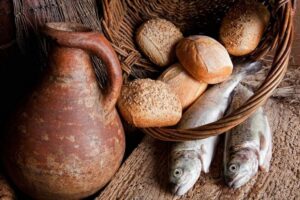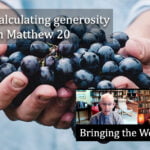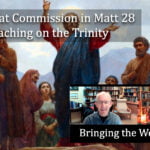 The Sunday lectionary reading for the Eighth Sunday after Trinity in Year A is Matt 14.13–21. We have now moved beyond the third section of Jesus’ teaching in Matthew, on the kingdom of heaven in chapter 13, and are immersed once more in Jesus’ ministry and engagement with those around him, which extends to the end of chapter 17, before we reach the fourth section of teaching in chapter 18.
The Sunday lectionary reading for the Eighth Sunday after Trinity in Year A is Matt 14.13–21. We have now moved beyond the third section of Jesus’ teaching in Matthew, on the kingdom of heaven in chapter 13, and are immersed once more in Jesus’ ministry and engagement with those around him, which extends to the end of chapter 17, before we reach the fourth section of teaching in chapter 18.
Here, as elsewhere, Matthew is much more compressed in his account that either Mark or Luke. There is a wealth of textual and emotional detail to consider here, and it is a good example of how concise the biblical texts often are, and therefore how carefully and patiently we need to ponder them.
The passage immediately preceding this episode, in all three Synoptic gospels, is the feast at which Herod Antipas presents John the Baptist’s head on a platter to his wife’s daughter. There is some irony in this juxtaposition; as R T France puts it (NICNT, p 558): ‘We move from Antipas’ lavish but degenerate feast to one with a simpler menu but a more wholesome atmosphere.’ In preaching, it would be interesting to reflect on the kind of feast offered by Jesus as a contrast to other feasts that are available.
In Mark and Luke, Antipas’ feast fills the gap between the disciples being sent out on mission and returning, whilst John fills this time by describing Jesus’ ministry in Jerusalem. But Matthew has told us about the mission earlier, in chapter 10, and so his focus here is solely on Jesus’ response to the news of John the Baptist’s grisly execution. There is a triple emphasis on Jesus action; he ‘withdrew’, ‘by himself’, and ‘to a lonely place’ (eremos, solitary, lonely, deserted). In Mark, this respite is partly for the disciple’s sake, as they take time out to recover from the exertions of ministry. But here, surely, there is a hint of Jesus’ reaction to the death of his relation and his predecessor. ‘Withdrawal’ is a favourite motif of Matthew; the magi withdraw from returning to Herod the Great in Matt 2.12; Joseph withdraws first to Egypt and then to Galilee in Matt 2.14, 22; and Jesus withdraws to Galilee, out of the territory of Herod Antipas, when John is first arrested in Matt 4.12. He surely sees the danger in open confrontation with political power, and knows that the moment for that has not yet come—but he also surely sees in John’s death an anticipation of his own destiny.
We might assume that Jesus really is on his own. But you need a crew to sail a boat, and the other gospels imply that the twelve disciples are with him.
Despite the emotional news about John, despite his own need for rest and his own concern for the disciples, when Jesus sees the crowd he has compassion on them, as he has before (Matt 9.36) and will have again (Matt 15.32, the feeding of the four thousand). The verb splanchnizomai (related to the origins of our word ‘spleen’) suggests being moved in one’s guts or stomach, believed in the ancient world to be the seat of the emotions. When Paul uses the related noun in Phil 1.8, the AV translates it ‘I yearn for you with the bowels of Christ’. It suggests a deep, spontaneous response, and for Jesus this overrules any sense of self-interest; he immediately shelves his own plans in favour of the needs of the crowds. In Mark 6.34 his response to these ‘lost sheep’ is to teach them; here in Matthew he heals the sick; the gospels all testify that he did both, and the accounts reflect the gospel writers’ different concerns.
Despite the traditional site of Tabgha, just west of Capernaum, marked by the Church of the Loaves and Fishes, the location is more likely to be east of the Jordan river near Bethsaida as Luke 9.10 informs us. There is a nice ‘undesigned coincidence‘ here, pointing to historical reliability: the account of the Fourth Gospel does not mention the location, but does mention that Jesus asked Greek-speaking Philip for information (John 6.5); and earlier in the gospel we learned that Philip was from the Greek-speaking region of Bethsaida (John 1.44). (There is a question of how the crowd, on foot, crossed the Jordan river; but we do not have enough archaeological detail to know whether there was a bridge or ford at the time.)
Although Matthew is more abbreviated than all the other gospels, so that we have no detail here of the money that would be needed (Mark 6.37), the discussion with Philip (John 6.5), or the little boy bringing his picnic (John 6.9—isn’t it interesting that the so-called spiritual gospel very often has the life-like vivid details that make the narratives seem so real?!), the main elements of the story are remarkably consistent across all four gospels.
For the disciples, there comes a point where their responsibilities end, ministry is finished, and the people need to be despatched so that they can have their own time. ‘Send the crowds away…’ But Jesus not only sees his ministry continuing, he invites the disciples to be involved in it and take responsibility, and sees it extending to provide for physical needs of the crowd and not merely the spiritual.
There doesn’t appear to be anything symbolic about the ‘five loaves and two fish’; this is just the number they had. Once more, the Fourth Gospel provides the detail that they were ‘barley’ loaves, the regular fare of the lower end of society (beware projecting our ideas of comparative poverty on a very different economy). The loaf would be something like our modern-day pitta breads, and assumed to be food for one. So whilst this offering is more than enough for one person, it would not even do for the Twelve, let alone the five thousand. Some years ago, William Barclay popularised the idea that there was nothing miraculous here in the multiplication of the loaves and fish, but that when the crowd saw the generosity of the boy, they were moved to share what they had in fact themselves brought—’the biggest miracle of all [is] one which changed not loaves and fishes, but men and women’. But this idea has no support whatsoever in the text itself, and is driven by a sceptical materialism.
It is entirely characteristic of Jesus that his miraculous power makes use of what is already there. Rather than produce food from nothing, he makes use of the loaves and the fish, just as at Cana he does not produce wine from nowhere but turns water into wine. Jesus’ miracles are consistently supernatural, working with and beyond nature, rather than antinatural. Jesus is no conjurer of magic tricks.
Matthew does not include Mark’s detail of the almost regimental organisation of the people, as they sit in ‘hundreds and fifties’ (Mark 6.40), nor the detail of the ‘green grass’ indicating that this was early in the year (Mark 6.39). But his abbreviated account does put Jesus centre stage and clearly in command. He commands the disciples, directs the people, and takes control.
Much has been made of the four-fold action of Jesus in ‘taking, blessing, breaking and giving’, and there are some very clear parallels between this narrative and Matthew’s narrative of the Last Supper—apart from the repeat of the four-fold actions, both take place in the evening, with people sitting (though is Jesus sitting here?), and there is an emphasis on ‘all’ eating. But three things need also to be noted.
First, all these are natural actions that we might expect; how else could the people be organised and eat other than sitting down? And the actions of Jesus are what any first century Jew would do.
Secondly, there is no doubt, reading in context as a narrative about observant Jews, that the ‘blessing’ is of God and not of the bread. This is confirmed by the interchangeable use in the gospels, in this account and in the Last Supper, of the verbs eucharisteo (‘to thank’) and eulogeo (‘to bless’). The blessing is of God (in Jewish liturgy the Berakhah) for providing food to nourish us, and this Jewish use of ‘blessing’ has been resurrected in contemporary Anglican liturgies (‘Let us bless the Lord’). It sounds odd, because it is really the equivalent of what we would now express as ‘praising’ or ‘thanking’ God.
Thirdly, the primary allusions here are not to later, ritualised church practice, but to previous episodes in Scripture. Crossing the water, arriving in a wilderness, organising the people into companies, sharing bread, having more than enough, gathering what is left—all these remind us of the provision of manna in the desert under the leadership of Moses. There are also strong parallels with the prophetic actions of Elisha in 2 Kings 4.42–44, when a large group are fed with a few barley loaves. Both here and in the Last Supper we see Jesus, in Jewish context and using Jewish customs, anticipating the heavenly banquet in parallel with his teaching about the kingdom of heaven, feeding the people with both words and bread.
There is no obvious precedent or symbolism in the number ‘five thousand’; the number is memorable enough in English because of the alliteration of the ‘Feeding of the Five Fousand’. Matthew alone notes that this number referred to the men alone, not counting ‘women and children’ who presumably were there also. There is, however, symbolic significance to the twelve baskets of surplus food, corresponding to the twelve tribes of Israel, though that is no reason to think this was imagined rather than actual. Jesus will provide for all of Israel, though his feast will also include many others, as we have already been informed (Matt 8.11).
It is tempting, particular in the first half of this passage, to read this in an anthropocentric way, that is, to read it as an example for us. We are not to be self-centred, limited and pre-occupied as the disciples are, but we are to be, like Jesus, compassionate, boundless, and generous beyond measure to those around us, to the lost sheep that cross our paths day in and day out. But the problem with this is, apart from making us rather than Jesus the centre of the story, we will experience a ‘hardening of the oughteries’ where our reading and preaching focus on what we and others ought to do, and it will lead to exhaustion and despair rather than grace and hope.
But the second half pulls us back to where our focus should be—on the person of Jesus at the centre of the narrative. He is the one who graciously meets our needs rather than focussing on his own; he is the one who empties himself, making himself a compassionate servant who brings insight and healing. He is the host at the messianic feast, where all are invited to eat and be satisfied.
If we do bring ourselves into the picture, it is only to ask: how will we respond to such a one, when he invites us to leave everything to ‘come, follow me’?
For further reflection on how to read and interpret the Bible well, you might be interested in my Grove booklet How to Interpret the Bible: Four Essential Questions.




























Is there significance in the men grouping themselves in “almost regimental organisation ” of 50s and 100s and that there were 5,000 of them – comparable to a Roman legion – e.g. The crowd is expecting the kingdom to be about national liberation?
i.e. are they getting ready for a battle?
Well, I am commenting on the account as we have it in Matthew, and the comment on organisation is made by Mark. I don’t think there is any battle/conflict motif in the Matthean account—though in the Fourth Gospel the people immediately try to make him king.
If there is a ‘battle motif’ in Mark, which some would argue (Myers, Horsley, post-colonial studies etc), then it is interesting that Matthew has removed it. Why? and what does that say about Matthew’s purpose in writing, compared to Mark?
Crowds going out to hear a prophet or a Messiah figure, or wanting to have a king (as John says) were seen as political by the Romans (Josephus lists several). I think we have overly depoliticised the gospels by not noting the constant conflict and oppression and imposition of Roman occupation, through taxation, control, and military presence – but others would argue that there is a modern agenda to politicise Jesus rather than attend to the spiritual!
Anything in Mark that is
(a) quite subtle and/or
(b) specific to the time of writing and/or
(c) would be the first to drop out if one did a precis or made a film
Matthew will generally leave out, not least because he may not fully understand it or its subtleties or specific reference.
As Ian said, any battle motif would be in Mark not Matt. Evidence in Mark:
(1) Legions were 4200-5000 men.
(2) They were divided into centuries or 100s (there is mention of groups of 100).
(3) We are talking ANDRES (men) numbering 5000. Matt picks up on this and wonders why the women and children had not been mentioned. So their not being mentioned struck a first century reader as odd. A battle motif could explain this.
(4) ‘Legion’ was mentioned a chapter earlier, also in Galilee.
(5) Galilee had just been ravaged by the legions in 67: so beginning from 3 years before the time of writing (and effects ongoing).
(6) The account of the demoniac Legion includes the hope of revenge for the mass precipice plunge at Gamala. See Rev. 18.5-6 – motifs often appear that show the Romans getting precisely tit for tat for the specific things they did – these are very frequent in Rev but also come in Mk.
(7) Ps 2.9 (a favourite of Rev and the only verse it *quotes*)- a ‘shepherd’ (Mk 6.34) is not necessarily gentle, can be ruthless.
(8) The name ‘Legion’ and the (possibly conceptually connected) division into centuries or groups of 100 are 2 relatively extraneous details which do not necessarily appear to be part of the tight logic of the main points of the passage. Yet in each case Mark includes them because he has contemporary interests that are missing from those who precis the stories for inclusion in (e.g.) a children’s Bible. So there could be a pattern here.
(9) How did armies feed? Was it by sitting down in centuries?
Also the green grass is possibly irrelevant and therefore is the other detail that arouses our suspicions.
The trouble is that Mark is absolutely full of such details, which are almost always omitted by Mt and Lk. This shows the vividness and eyewitness nature of his account.
If the green grass has an extrinsic significance it could be that Feb-March (when the grass shows signs of spring but before it is parched) is the start of the battle season. The figtree in chs 11,13 also align summer with the battle season if as most think there is a reference to the fall of Jerusalem and/or temple’s fate within the figtree material.
Some cite 1 Kings 18.13, where (a) exactly the same 2 numbers 50 men and 100 men are mentioned; (b) the context concerns feeding them; (c) the broader context is Elijah and Elisha whose feeding miracles are the closest thing to Jesus’s (but not all that close).
If Mark mentions the 50 and 100 on the basis of that passage it could be either subconscious or deliberate. The existence of such an echo would certainly help solve the puzzle of why the groups were not all 50s or all 100s but rather a mixture. Yet that could have been achieved in a neater and also more precise way by speaking of 50×100. And that would have been closer, too, to the original which is a multiplication sum: 2×50=100.
More likely then that the 50s and 100s were how people knew there were 5000 people in the first place. Jesus sees the people as sheep without a shepherd. He (a) arranges them neatly in pens, imposes order as shepherds and sheepdogs do; and (b) then feeds them, as shepherds do. As ever, Mark seems so much closer to the events than Matthew.
What a sight. The first Flash Mob. All those people like flowers appearing in the field. Here today, gone tomorrow. And Jesus comparing a flower to Solomon and declaring something greater than Solomon is here. And we, like bees fly to him. This fragrance.
Sorry Ian, I’ve gone all poetic and went wandering.
Like the oughties bit.
You are in good company. God went poetic and wandering too, eg Job chapters 38-41.
Ah. I love the way Elihu’s monologue gets drowned out by the storm and God takes over like the Great Moderator in a blog!
We could all do with some of that.
Poetry is the best way to examine Paradoxes.
Hi Ian,
I’m interested in the way Herod had a feast and Jesus gives a feast and the contrast you draw out. Was Herod down by the dead sea at the time of the beheading of John or was he in some other palace. Sephoris perhaps? John’d disciples would have had a 12 day hike from Herod’s winter palace but only a days journey if it was Sephoris they travelled from.
Josephus says John was imprisoned and executed at Machaerus on the shores of the a Dead Sea, I think.
According Wikipedia
Machaerus (Μαχαιροῦς, from Ancient Greek: μάχαιρα, lit. ‘Makhaira’ (a sword); Arabic: ِقلعة مكاور Qal’atu Mkawer; Hebrew: מכוור Mikwar ) is a fortified hilltop palace located in Jordan 25 km (16 mi) southeast of the mouth of the Jordan river on the eastern side of the Dead Sea. According to Flavius Josephus, it is the location of the imprisonment and execution of John the Baptist.[1]
All the commentaries I have read link Jesus’ search for solitude with the news of John’s death. That makes sense but the timeline does not seem clear. Chapter 14 starts with Herod’s observation that Jesus must the be the baptist risen from the dead, which accounted for the miracles he had heard reported. We then move into an account of that death, which obviously predates Herod’s statement. Is Jesus responding to the news of John’s death, or is he responding to the news that Herod was thinking that he was the Baptist reincarnated?
I think he is responding the news of John’s death. The introductory comment makes the account of the death a flashback, and contributes to the sense of Jesus as a threat to Antipas.
The disciples had a mindset of scarcity – they could only see what they perceived as their meagre five loaves and two fish. Jesus, on the other hand had a mindset of abundance. He took their scarcity, blessed it, broke it and gave it back to them in abundance. Is it the disciples who fed the 5000 rather than Jesus. He told the disciples ‘You give them something to eat’. Jesus uses the resources we have (abundance) not what we don’t have (scarcity). This is often what happens when we offer our talents in faith – our offerings are blessed, broken and given back to us in abundance.
Thanks Brian. I can see the pastoral helpfulness in this. The only problem is that Jesus does not bless the bread; he blesses God.